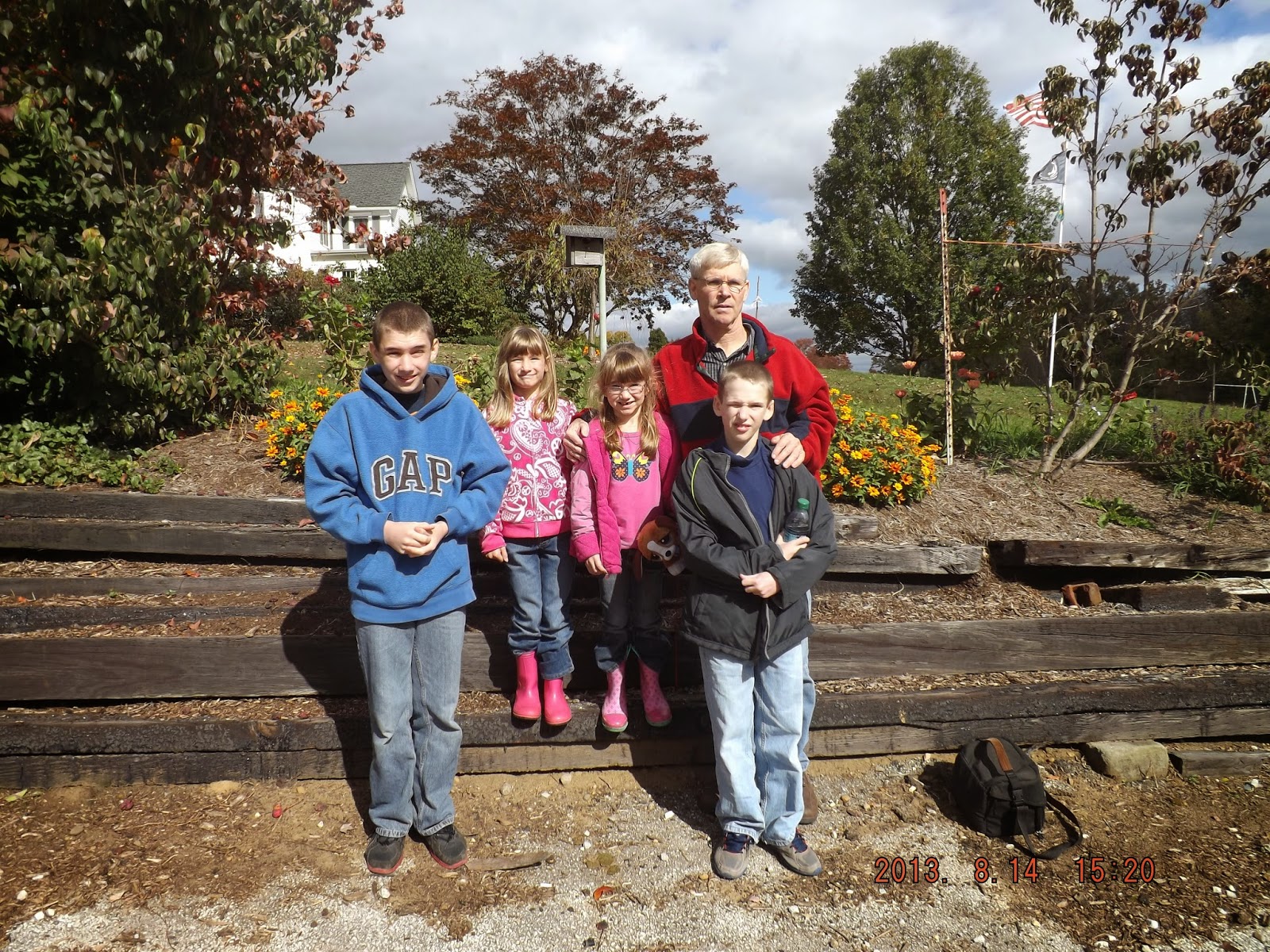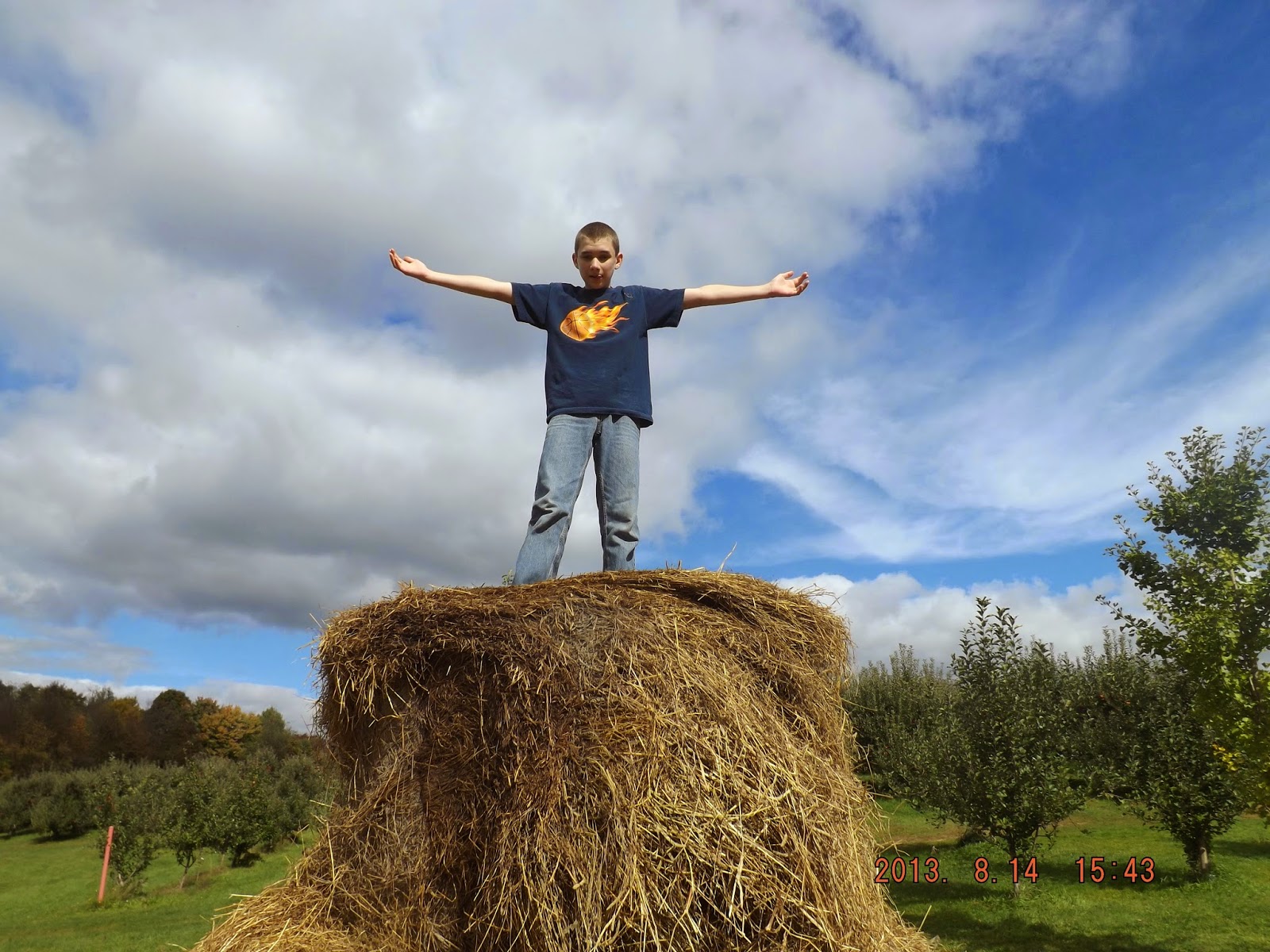Boys' Science Notes
This week my boys, ages 11 and 12, watched a DVD that came with their Core G Sonlight Science, entitled Icons of Evolution.
Product Description
Are students learning the whole truth about Darwin's theory of evolution? According to a growing number of scientists, the suprising answer is no. They claim that many of the most famous "Icons of Evolution"--including Darwin's "Tree of Life," finches from the Galapagos Islands, and embryos that look remarkably similar--are based on outdated research and sloppy logic. They say students are being hurt by the failure to present both sides of an emerging scientific debate over Darwin's theory.
From the Galapagos Islands to China, Icons of Evolution will take you on a fast-paced, fascinating journey into one of the most controversial issues in today's public arena.
My Notes: This DVD deals with each of the major points of evolution and analyzes them from a scientific perspective. There is a widely held perception that the only scientists who have problems with evolutionary theory are those with religious views. In fact, many are skeptical due to the poor science involved in evolutionary theory, but these scientists are ostracized in the field. This DVD gives them a voice (and also includes pro-evolution scientists), and it highlights how far public schools will go to keep sound, unbiased science from reaching their students.
Come explore this fascinating new conflict over evolution in the classroom--a conflict based on science, not religion. Learn about the controversy that engulfs one town when a teacher actually tries to tell students that some scientists disagree with Darwin.
Review: True science and freedom of thought are inseparable, but as this video shows, some scientists prefer power to truth. -- Philip Johnson, author of Darwin on Trial
This DVD definitely supports the often scoffed at view that public schools are also propaganda machines. Indeed, it may be true that all education is inevitably propaganda, so all the more reason to control the message as best we can as parents, while encouraging critical thinking.
Ministering to Neighborhood Children (related to the evolution topic, and worthwhile books)
We had two neighborhood children over for dinner last night (not siblings of each other), and as my older son brought up what he's learning in science, one of the friends said that no, God didn't have anything to do with the creation of the world. It all happened over many, many years, he said, confident in his view. This is the same friend of ours who came to Christ recently, and this exchange made me realize how hard it is for a child from a non-Christian home to grow in Christ. Any discipling he gets will be through us, at least at this juncture.
Whether one believes in evolution or not is certainly not a crucial point, but the belief that God has nothing at all to do with creation, means that the child doesn't understand the majesty and power and omniscience of our Heavenly Father.
This child is the one I am babysitting a couple nights a week. On Thursday nights at 7 PM we go to a library program so my son Paul can have some regular art in his school week. Our neighbor then, age 9, goes with us, and loves to check out Goosebumps books on my library card. I'm horrified at these books--especially the covers, but I haven't read any. The librarian confirmed for me that they are indeed scary. I don't need to peruse them to know they aren't adding any value to this child's life--and in fact, they are probably desensitizing his heart. Our hearts need to be nurtured and fed thus:
Finally, brothers and sisters, whatever is true, whatever is noble, whatever is right, whatever is pure, whatever is lovely, whatever is admirable--if anything is excellent or praiseworthy--think about such things. Philippians 4:8
Discipling Neighborhood Children Who Do Not Have Christian Parents
The Holy Spirit guided me at the library in the last two weeks, however, with the reminder that the Father will work on one thing at a time in this child's heart, and I am to follow His lead. First, for instance, I must teach the truth of the above verse, and then wait for the Holy Spirit to speak to this child's heart about scary books and movies. To this end, I have copied the verse on chart paper and posted it in my house, as a conversation starter. Children notice what is written on large chart paper, and so I use charts as a tool as we minister to neighbor children.
The following is a chart I have up to teach them about having a prayer life, and what breadth of things we can appeal to our Heavenly Father about. Even my own children benefit from having it posted, to remember that we are called to have a prayer life--one rich in what is important to God, not merely superficial. This is just one chart that details how we pray for children.
In Other School News: silent e and b/d confusion
My daughter Mary (an All About Reading Level 2 student) learned that the silent-e rule is also called the "name game syllable". As such, the silent e goes up to the vowel, who he met at a party, and says, "Hi, what's your name?"
This is a semantics change from the way I taught silent e, and the language used makes more sense to children. My daughter is remembering more often what to do when she encounters silent e in her reading.
She also learned that lower case b is also called "bat ball" to signify that the stick goes first, then the ball. Conversely. lower case d is called "doorknob door" to signify that the doorknob goes first, then the door. These tips are helping my dyslexic daughter tremendously, as I remind her to ask herself what comes first when her finger comes upon a b or d word. Does your finger touch the bat first, or the doorknob? Having the child move the finger under the word in the same direction we read, is a crucial part of using this b/d trick successfully. Otherwise, without this directional cue, they see the stick and ball and can't make sense of it (since b and d both have a stick and ball).
If the b/d confusion doesn't clear up by the beginning of second grade, it's time to think about possible dyslexia. Before second grade, it's fairly normal to confuse the two.
Birthday Notes
My middle son turns 11 this weekend, followed by three more child birthdays fairly quickly. All four of mine were born between November 2nd and January 11th, with the girls' birthdays only one week apart on the December calendar. Makes for a busier couple months with the holidays thrown in the mix.
My middle son turns 11 this weekend, followed by three more child birthdays fairly quickly. All four of mine were born between November 2nd and January 11th, with the girls' birthdays only one week apart on the December calendar. Makes for a busier couple months with the holidays thrown in the mix.
2014 Picture Books to Highlight (to be added to my picture books blog pages)
Science
Animal School: What Class Are You? by Michele Lord
Synopsis: In this poetic exploration of the five vertebrate
classifications—mammals, birds, reptiles, amphibians, and fish—animals come to
life in lush color. Each class gets the spotlight in breathtaking digital
woodcut art accompanied by rhythmic, kid-friendly poetry. With a focus on
trademark characteristics, such as birds’ beaks or the scales of fish, the book
explains the differences between the five classes. Back matter includes an
index and a glossary of scientific terms, as well as a table with information and
examples from each classification for cross-referencing.
National Geographic Kids: Seed to Plant by Kristin Baird Rattini
Synopsis: A plant is a living thing . . . that grows and changes, just like you. Beginning with its opening line, this National Geographic Readers title will spark kids’ curiosity. From interactive dialogue (How many plants did you eat today?), to basic diagrams, to plant jokes and Buzzword word banks that are included on the photographed pages, the text keeps readers engaged and asking questions. Tightly organized, the text also builds on itself, with introductory information about plants and how they affect other organisms to concluding opportunities for applying the information with the appended directions on how to grow a bean plant, as well as quizzes to test new knowledge. Through a fun and simple lens that is perfect for the new, curious reader, this title celebrates a plant’s special place in the world. Preschool-Grade 1
The Little Raindrop by Joanna Grag
Hope For Winter: The True Story of a Remarkable Dolphin Friendship by David Yates
Synopsis:
A story of a baby dolphin named Hope is rescued against all odds.
Exactly 5 years and 1 day after Winter, the tailless dolphin who inspired a major motion picture featuring Morgan Freeman, Ashley Judd, and Harry Conick Jr., was rescued, something pretty amazing happened. Just feet from where Winter was found, appeared another injured dolphin, orphaned from her mother and struggling to survive. The Clearwater Marine team quickly went to work, attempting to nurse this new dolphin back to health. After a tough fight fought by the little dolphin and by the Clearwater team, the dolphin grew strong and healthy. She now lives with Winter and crowds flock to the aquarium to see them play. Her tale is one of courage and triumph. She was named Hope and this book tells her story.
Social Studies
The History of Money: From Bartering to Banking by Martin Jenkins
Publisher Synopsis:
What can take the form of a stone with a hole in the middle, a string of shells, a piece of paper, or a plastic card? The answer is money, of course. But when did we start using it? And why? What does money have to do with writing? And how do taxes and interest work? From the Stone Age to modern banking, this lighthearted and engaging account traces the history of the stuff that makes the world go round.
This is not your standard children’s review of the historical shift from barter to currency, with emphasis on exotic media for trade, culminating in our own paper and coinage. Instead, this is a post-2008 financial meltdown essay, broken into short, lively chapters tinged with tart humor, that walks kids through development of money and money-lending. ... A spacious layout and Kitamura’s delightful cartoon vignettes make the dense topics of taxation, interest, and inflation, and international currency valuation less daunting.
—Bulletin of the Center for Children's Books
All Different Now: Juneteenth, the First Day of Freedom by Angela Johnson
Synopsis: Gr 3 Up—Previous picture books about Juneteenth (the holiday celebrating the day slaves were freed in Texas—two years after the rest of the country) have focused on contemporary children discovering this quirk of history. Valerie Wesley's Freedom's Gifts (S. & S., 1997) and Carole Boston Weatherford's Juneteenth Jamboree (Lee & Low, 1995) fall into that category. Johnson imagines what it would be like to be a slave one minute and a free person the next. Spare text, structured as free verse, hones in on the smell of honeysuckle and breakfast routines as the day begins, like any other. The titular phrase appears three times: first to build suspense, then to indicate the earthshaking import of the message spreading from the port, and, finally, to reflect on the consequences. Lewis paints details not mentioned. The protagonist is a girl living in the slave quarters with her siblings and mother. They are working in the cotton fields when the news arrives. Skillful watercolor renderings depict nuanced changes in lighting and focus, thereby capturing individual responses to a community's new reality—from incredulity and quiet contemplation to rapture. Occasional panels indicate passing time; the brilliant clarity of the fields at noon fades to a green-blue gauze over the revelers heading home from a late-night celebration. A time line, glossary, overview, list of websites, and notes by author and illustrator provide deeper understanding. With a narrative notable for its understated simplicity and lack of judgment, this title allows readers to draw their own conclusions. An affecting entrée to a challenging conversation
My note: There are few words to this text, but the words included are beautiful. Within the first two pages, your tears will flow over the magnitude of what the characters experience on their first free day. It is as though you are there, experiencing their surprise and joy. Don't miss this one!
William Shakespeare: A Man For All Times by Paul Shuter
Synopsis: Grades 7-9 Who was William Shakespeare? How much do we really know about him, and how much of what is believed is myth? This unique biography takes the reader step-by-step through Shakespeare's life, setting out the evidence and what we can reasonably infer about him. It reminds the reader about the world he lived in, such as that standard spelling of words did not exist in his time, and shows how we must think carefully before applying modern ideas to explain his life.
My Note: Chapters include: who was Shakespeare; where did he come from; after school and marriage; what happened next; moving to London; what makes him different; was he rich; the King's man,; did Shakespeare retire; money then and now; glossary; source references; find out more; epilogue.
My boys are learning about Shakespeare later this year as part of Sonlight Core G, (World History Part 1). We will definitely include this source.
Thanks for reading here! Have a great weekend.






































